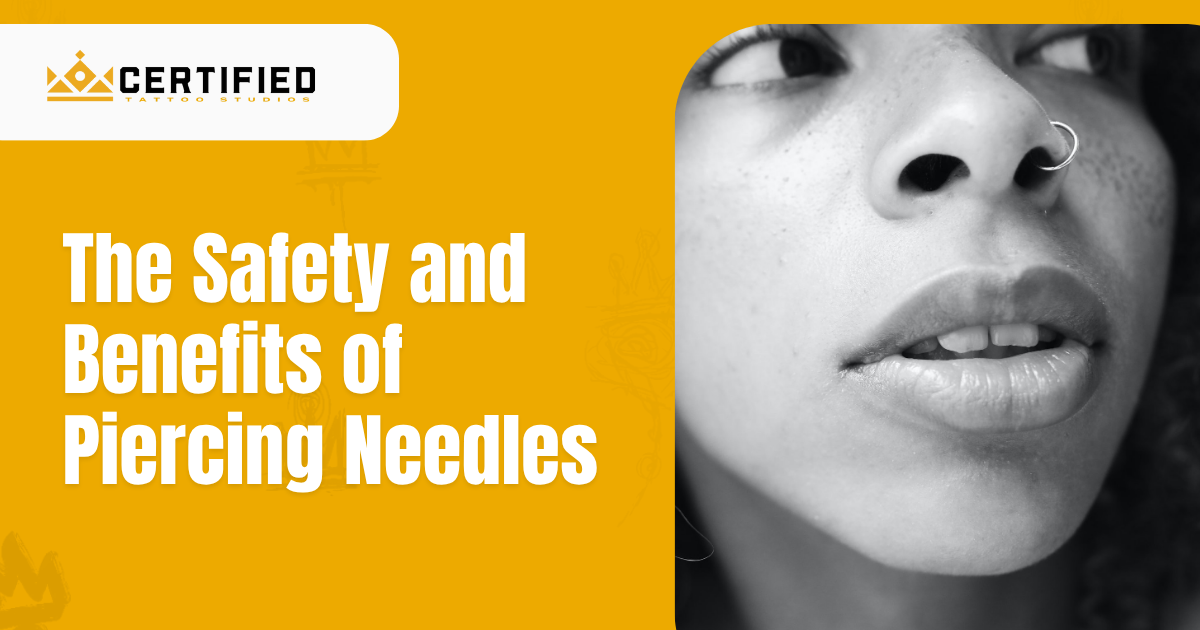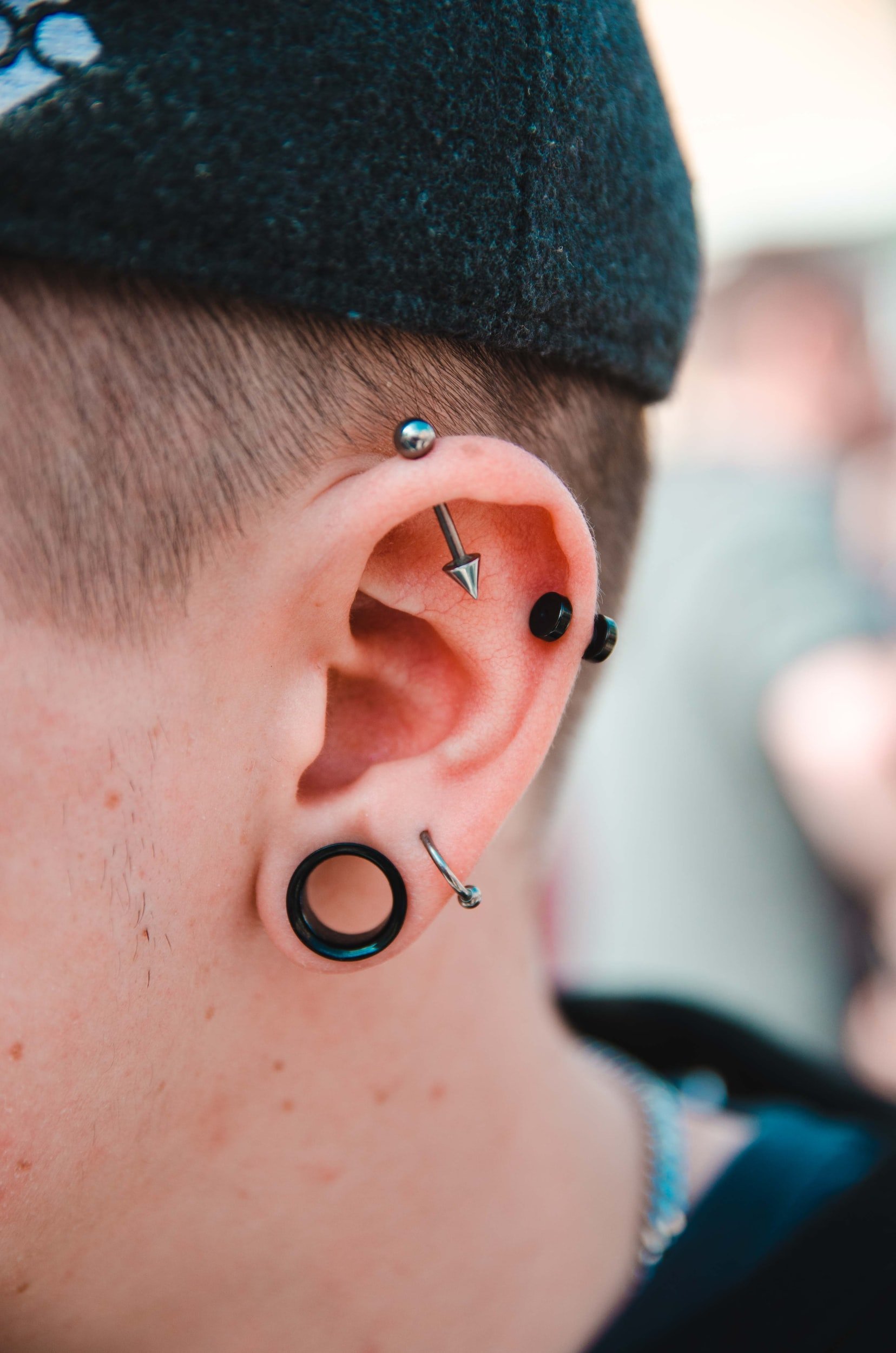The Safety and Benefits of Piercing Needles
We know the mere mention of needles can send shivers down your spine, but hear us out. Have you ever considered the safety and benefits of piercing needles? That's right, we're talking about the nose piercing needle and ear piercing needle. Don't worry, we won't judge if you need to take a deep breath before continuing. But trust us when we say that these little guys are more than just tools for body modification – they have some serious advantages that might surprise you.
So grab your favorite stress ball and let's dive into the world of piercing needles together!
How are piercing needles used safely?
While peircieng to create holes in body piercing needles are used. To reduce damage and pain tri-bevel tip is used. The size range of needles ranges from 18g to 10-12g. Smaller one for ears/nose and larger one for lips or brows. Also, needle types are different, like straight, curved, and cannula styles for easy jewelry insertion. Professionals sterilize the needles before using and use needles on a single person to reduce infection risks.
The Safety of Piercing Needles
When it comes to piercing needles, safety is of the utmost importance. Professional piercers follow strict safety standards when performing body piercings, including the sterilization of all equipment used and the proper use of protective gear. However, if you are considering a DIY piercing, we recommend you just don't. Sure it may seem like a fun idea at first, but your health and well-being should always come first!
When performing a professional body piercing, most piercers will use a hollow needle between 14 and 18 gauge in size. The larger gauge number indicates a smaller diameter needle (i.e. 14g needle is thicker than 18 gauge). The type of needle used depends on the type of piercing being performed as well as the anatomy of the person being pierced. For example, ear lobe piercings can generally be done with larger needles such as 14 gauge piercing or 16 gauge while cartilage piercings often require smaller needles such as 18 or 20 gauge.
Speaking of which - when it comes to body piercings there is no room for compromising because using anything other than sterile single-use needles can lead to infections and other blood-borne illnesses.
So what about the piercing gun vs needle debate?
Piercing guns are not advised for any type of ear or body piercing due to their inability to properly sterilize and they should never be used on cartilage or surface piercings because they can cause serious damage to tissue cells within the skin. Additionally, since guns force jewelry through the flesh rather than creating an opening with a sharp point (like with standard hollow needles), surface and cartilage healing times can be significantly increased due to improper placement of jewelry in the skin.
Ultimately, whether you opt for professional services or attempt a DIY piercing – safety should always come first! Professional piercers must go through extensive training and certifications before they are allowed to pierce anyone so ensure that all sanitation guidelines are followed when getting a professional body piercing – trust us it’s worth taking every precaution necessary! Well…unless you have been looking forward to rocking that “DIY blunder” look this season ;)
Benefits of Piercing Needles
Piercing needles have long been the preferred tool of choice for body piercing professionals due to their precision and ability to reduce healing time. But what many people don’t realize is that not all needles are created equal - there are differences in size and sharpness which can make a huge difference in the safety of the procedure.
The 10g needle (or 1.0mm) is considered by many professionals to be the “standard” size for most piercings, as they provide an adequate level of penetration without adding unnecessary trauma or damage to the skin. These needles produce a “punching” action when inserted into the skin, giving them the name “punch-in” needles. They also cause minimal trauma and bleeding, making them ideal for larger areas such as ears, noses and eyebrows.
The 12g needle (or 1.2mm) is slightly thicker than 10g needles and are best used on smaller areas such as lips, nostrils or nipples. These larger-sized needles require more force during insertion to penetrate deeper into the tissue and create a larger hole than smaller sized needles would produce. While these larger sized needles may seem intimidating at first, they actually cause less pain and bleeding than smaller ones due to their greater bluntness! This makes 12g needle piercings safer overall since they cause less trauma and allow for quicker healing times compared to 10g needles.
So while piercing with any size needle might sound scary at first, rest assured that body piercing professionals take great care in ensuring that your procedure is performed safely regardless of needle size! After all, when it comes down to it – it’s about creating beautiful body art; not putting yourself in harm’s way!
Common Myths and Misconceptions about Piercing Needles
Myth #1: Piercing needles are the same as sewing needles
Ah, the classic myth that can make anyone shudder at the thought of a 17 gauge needle going through their skin. Let's set the record straight: piercing needles are specifically designed for the purpose of piercing and are made of surgical steel, making them much safer and less painful than a dull old sewing needle.
Myth #2: Piercings always get infected
This myth is the equivalent of saying that every time you eat an avocado, you'll get food poisoning. It's simply not true. While infections can happen with any wound, if you go to a reputable piercer, follow their aftercare instructions, and avoid touching your piercing with dirty hands, your risk of infection is incredibly low.
Story time!
I once knew someone who refused to get a piercing because they were convinced that the needle would get stuck in their body and they would be forced to walk around like a human pincushion for the rest of their life. While this may seem like an extreme case, it just goes to show how silly misconceptions can be. Rest assured, a piercing needle will not get stuck in your body. It's designed to go in and come out smoothly, leaving you with a fabulous new piece of jewelry.
Myth #3: Ear piercings are less painful than nose piercings
Sorry to burst your bubble, but pain is subjective and depends on the individual. While it's true that the cartilage in the nose can be more sensitive than the earlobe, the pain level ultimately varies from person to person. And remember, the 17 gauge needle used for ear piercings is the same as the one used for nose piercings, so don't let this myth sway your decision.
Don't let these common myths and misconceptions scare you away from getting the piercing of your dreams. As long as you do your research, go to a professional piercer, and take care of your piercing properly, you'll be just fine (and stylish).
HOw to Take Care of Your Piercing
Taking care of a piercing can be a daunting task, but it's important to maintain good hygiene in order to prevent infections and keep the piercing looking great. Here are some helpful tips on how to take care of your piercing and make sure it stays healthy:
1. Cleanliness is key! Make sure you wash your hands with soap and water before touching or cleaning any part of the piercing. Also, use a fresh cotton swab every time you clean your piercing so you don’t spread germs from one area to another.
2. Use an antibacterial soap like Dial or Cetaphil to clean the area around your piercing twice a day (morning and night). You can also use either salt water solutions or over-the-counter cleansers specifically designed for piercings. Just follow the instructions on the product label for best results.
3. Avoid wearing tight clothes that rub against your piercing as this can cause irritation and infection. If possible, try not to wear any clothing over the pierced area at all - hey, if it's allowed in public, go for it!
4. Don't twist or move the jewelry when cleaning or remove it unnecessarily as this can disrupt healing process and irritate the skin around the area too much.
5. Be sure to check if there is any redness, swelling or discharge coming from the area - these are signs that something might not be right with your piercing and that you should see a professional doctor immediately.
6. Finally, enjoy yourself! It can be tempting to touch your new bling but try not to play with it too much as this increases risk of infection too - plus, we don't want anything getting caught in your clothing!
Frequently ASKED questions
-
A: The needle used for piercings typically depends on the type of piercing being performed and the preferences of the piercer. However, most professional piercers use single-use, sterilized, hollow needles specifically designed for the purpose of piercing. These needles come in various sizes, commonly referred to by their gauge, with larger numbers indicating smaller needle diameters. Thicker gauge needles are typically used for areas of the body that require a larger hole, such as the tongue or genitalia, while thinner gauge needles are typically used for smaller areas such as the earlobes or nostrils. It is important to note that piercings should only be performed by trained and experienced professionals using proper equipment and sterile techniques to minimize the risk of infection and other complications.
-
A: The gauge of needle used for piercing depends on the specific location and type of piercing being done. Generally, smaller gauge needles (18-20) are used for ear and facial piercings, while larger gauge needles (12-14) are used for body piercings. It is important to consult with a professional piercer to determine the appropriate gauge for your specific piercing.
-
A: Needles and guns can both cause pain, but the level of pain can vary depending on the individual's pain tolerance and the location of the injection or gunshot. Injections from needles tend to be more focused and precise, while a gunshot wound is usually larger and can cause more tissue damage. Ultimately, the level of pain can differ based on the situation, but both needles and guns have the potential to cause significant discomfort.
Curious about piercing needles?
Contact us to
learn more!
READ MORE…
Read up our article on how much is a nose piercing at a tattoo shop?
Check out the history of piercings.
Here are 4 body piercing misconceptions that you shouldn’t believe.





